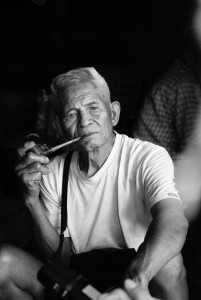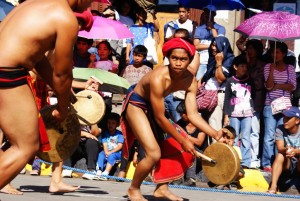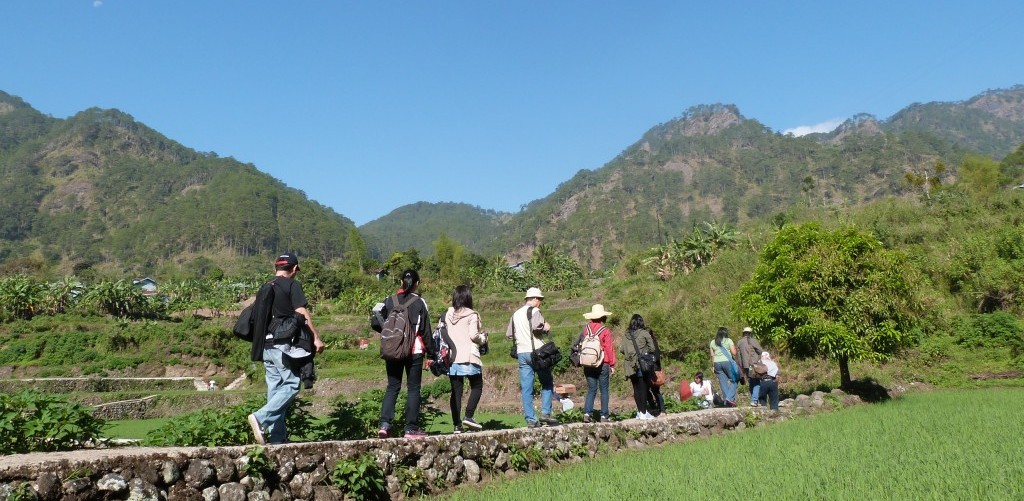The summer sun was at high noon but the cool breeze shielded us from the heat and we shivered slightly. Holding our recording devices, we watched as the children from Sagada rehearsed their dances and gong-playing, wearing their traditional costumes. Our team, staff from the UP Center for Ethnomusicology in UP Diliman, Quezon City lead by Dr. Ramon P. Santos, and the National Taiwan Normal University in Taipei, Taiwan, headed by Dr. George Chien, arrived the day before for the Field Exchange Research Project.
This project brings together two institutions from the Laon-Laon network to conduct musicological research in an agreed field area. Audio, video, still photographs and field notes are collected by both teams. By the end of the research, the data is shared and widens the scope of the collected data for each institution.

Earlier that day, on April 1, 2014, digitized recordings from 1953 of Lester Brooks and 1960 of Jose Maceda in compact disc format were repatriated and turned-over by Dr. Ramon P. Santos to the municipal mayor, Eduardo Lantawan, Jr. This simple ceremony was done in front of the Municipal Hall just after the Monday morning flag ceremony.
As the children continued rehearsing, we learned through interviews with the teachers present, that the whole town was preparing for their participation at the Lang-ay Festival to be held in a few days at Bontoc. Though the street dancing was choreographed, the gong-playing and movements were still based on tradition.
After documenting parts of the rehearsal in the first day, we proceeded to Ankileng on the second day. A begnas or gathering of elders was being held at a house where one of the family members had passed away. After the cañao, a general term for ritual with the offering of a pig, the elders and research team gathered at a seating area below the house. Here we asked the elders, led by Manuel Kimayong, about their old songs. We then played audio clips from the Brooks and Maceda recordings. Goosebumps travelled up and down our spine when they identified the area where a song came from, who taught that particular song. Soon enough, they sang along with the recording.
On the third day, we went to Demung, to the house of Esteban Bosaing, a lakay or elder. We interviewed him about the traditions and old ways of the Kankanaey. He brought us to his dap-ay or a place where people gather for the begnas. Here, aside from finding out the tree was called kuba, a very surprised Dr. Chien shared that in one of the indigenous groups of Taiwan, they had a similar ritual area with a tree that they also called kuba. In one area was a padaw where the heads of the head-hunting tribal wars were buried. Amazingly, a similar area can also be found in the indigenous ritual grounds they researched in Taiwan.
We were invited by a family that was having a ritual for a good election result. The patriarch was running for local office and a ritual was to be done at their house. After the cañao using chickens, reassuring words were said to the household. However, the lakay avoided saying outright what the result of the election would be.

On April 6, the team went to Bontoc for the Lang-ay Festival. The whole town was alive with color and the sounds of gong music. Local and international tourists filled the streets where the street dancers would pass. Representatives from the whole Mountain Province were present. Children, teenagers and adults were grouped and ready in their colourful costumes and choreographed moves.
Under the covered court where each group’s final presentation was performed, our team members were positioned at various strategic areas for the best sound and visual documentation. Our hard drives and other saving devices were full to the brim at the end of the day.
As we took one last look at the performers who were sitting in groups, having a late meal, a shiver rolled down our spine – this time, not from the cool breeze that blew, but from the amazement at the richness of Philippine culture as embodied by these Cordillera treasures.

